 advertisements advertisements
|

|
Astronauts on SpaceX capsule make first US splashdown in 45 years
August 2, 2020 — Two NASA astronauts flying on SpaceX's first crewed capsule have safely splashed down from the International Space Station, marking the first water landing by an American crew in 45 years.
Bob Behnken and Doug Hurley returned to Earth on Sunday (Aug. 2), two months after becoming the first astronauts to launch on a commercial spacecraft to the space station. Descending under parachutes, the SpaceX Demo-2 (DM-2) Dragon capsule "Endeavour" was dropped into the water about 39 miles (63 kilometers) south of Pensacola, Florida, at 2:48 p.m. EDT (1841 GMT).
"Endeavour, on behalf of the SpaceX and NASA teams, welcome back to planet Earth and thanks for flying SpaceX," radioed Mike Heiman, SpaceX's CORE (Crew Operations Responsible Engineer) from the company's mission control in Hawthorne, California.
"It was truly our honor and privilege to fly the [maiden] flight of the Crew Dragon Endeavour," replied Hurley.
The landing was the first time that a crewed spacecraft splashed down in the Gulf of Mexico and the first U.S. mission to end in any body of water since the Apollo-Soyuz Test Project in July 1975. SpaceX's prime landing site, off the coast of Cape Canaveral in the Atlantic Ocean, was unavailable due to the conditions caused by Tropical Storm Isaias.
SpaceX dispatched a small fleet of boats to recover Behnken and Hurley aboard Endeavour. A modified platform supply vessel, the GO Navigator, was configured to hoist the Dragon out of the water. The astronauts reported that they were doing well, despite pre-landing concerns about possible sea sickness.
Dragon departing
Behnken's and Hurley's return to Earth began on Saturday, the day before their splashdown. Assembling in front of same hatchway where they had docked and come aboard the space station on May 31, Behnken and Hurley bid goodbye to their Expedition 63 crewmates, Chris Cassidy of NASA and Anatoli Ivanishin and Ivan Wagner of the Russian federal corporation, Roscosmos.
"We were reminded fairly recently that we're at about the 45th anniversary of the Apollo-Soyuz Test Project, which is also the last time a U.S. spacecraft splashed down, rather than landed on the land," said Hurley during the brief ceremony. "It is kind of neat to have that mission that exemplified the teamwork between Russia and the United States — back then, the Soviet Union and the United States, but now Russia — and to share this expedition with Anatoli and Ivan."
The astronauts then loaded the Dragon with about 330 pounds (150 kilograms) of science results and spent station equipment for the return to Earth. They also packed a few personal items that they wanted to bring home, including a U.S. flag that had previously been flown on the first and last space shuttle missions, a plush Earth that was left behind by the earlier uncrewed SpaceX Demo-1 test mission and a sequined toy dinosaur that they brought with them to the orbiting laboratory.
"I think my son and Doug's son are really excited not only to get their fathers back, but to get our apatosaurus, our 'zero-g indicator,' that they nominated to go with us on this historic mission," said Behnken. "For Jack and Theo, 'Tremor' the apatosaurus is headed home soon and will be with your dads. You'll have to pick which one of us is your favorite."
Following one more meal as members of the station's crew, Behnken and Hurley boarded the Dragon and the first of three hatches between the spacecraft and station was closed at 5:36 p.m. EDT (2136 GMT). About two hours later, after the remaining hatches were sealed and a final "go" was given by flight controllers on the ground, Endeavour undocked from the forward port of the Harmony node at 7:35 p.m. EDT (2335 GMT).
"Dragon departing," radioed Cassidy, after ringing a ship bell, continuing a tradition that was started by the station's first crew 20 years ago.
"It has been an honor and a privilege to be part of Expedition 63," said Hurley. "It has been a great two months and we appreciate all you've done as a crew to help prove out Dragon on its maiden flight."
Return to Earth
Two brief bursts and four short burns by Endeavour's Draco thrusters, executed over the course of two hours, propelled the capsule away from the space station and adjusted the Dragon's orbit to line up with a landing off the coast of Florida. Behnken and Hurley were then able to relax and get about seven hours of sleep.
"Good morning Dragon Endeavour! I am happy you went into space but I am even happier you are coming back home," said 10-year-old Jack Hurley in a recorded wake-up call for his father.
Wake up, wake up, wake up!" added 6-year-old Theo Behnken. "Don't worry, you can sleep in tomorrow. Hurry home so we can go get my dog!"
Activity picked up again on Sunday at 1:52 p.m. EDT (1752 GMT) with the jettison of the Dragon's rear-mounted trunk. Lined on one side with solar panels, the trunk provided power to the spacecraft while on orbit.
"Oh yeah, we felt it," reported Hurley as the trunk separated.
Five minutes later at 1:56 p.m. EDT (1756 GMT), Endeavour preformed a deorbit burn, firing its thrusters for 11 minutes and 22 seconds, which slowed the Dragon's orbital velocity and aligned its descent.
"Nominal burn," radioed Hurley.
The Dragon's nose cone was commanded closed, shielding the docking hardware that was used to connect to the station, and the spacecraft was maneuvered to its entry attitude before Endeavour encountered the upper traces of the atmosphere. Communications were lost with the crew for about six minutes due to the build up of atmospheric entry plasma around the capsule.
"Endeavour has you loud and clear!" said Hurley, replying to a comm check from SpaceX mission control after the blackout ended.
The spacecraft deployed its two drogue parachutes at approximately 18,000 feet (5,500 meters). Just seconds later, at 6,500 feet (1,980 m), the drogues detached and four main parachutes unfurled, which then lowered Endeavour to the water.
Helped out of their capsule after SpaceX's recovery team worked to clear residual thruster propellant (nitrogen tetroxide) vapor near the hatch, Behnken and Hurley received brief medical checks and then boarded a helicopter for Naval Air Station Pensacola, where a NASA Gulfstream jet aircraft was ready to fly them to Ellington Airport, near the Johnson Space Center, in Houston.
"I just wanted to thank you guys for bringing us home safe before I disembark from the good ship Endeavour," said Behnken, addressing the team in Hawthorne. "Thanks for doing the most difficult parts and the most important parts of human spaceflight, getting us into orbit and bringing us home safely."
"I would like to add my thanks to everybody... anybody who has touched Endeavour, you should take a moment to cherish this day, especially given all of the things that happened this year," added Hurley. "Just proud to be a small part of this whole effort to get a company and people to and from the space station."
Endeavour will be delivered to SpaceX's Dragon Lair in Florida for inspection and post-flight processing. (The same spacecraft is scheduled to fly again in 2021 with a crew that includes Behnken's wife, NASA astronaut Megan McArthur.)
Names and numbers
During their DM-2 test flight, joint operations commander Behnken and spacecraft commander Hurley helped to conduct science and maintain the space station's systems, while also evaluating the Dragon's performance on orbit. During a July 8 hour-long test, the two astronauts were joined by Cassidy and Ivanishin on board Endeavour to assess the ship's comfort in preparation for future Dragon missions with four people aboard.
Behnken also joined Cassidy for four spacewalks outside of the station to upgrade batteries and configure the complex for future upgrades. The EVAs (extravehicular activities) were enough for both crewmates to tie the American record of 10 for the most career spacewalks.
DM-2 was both Behnken's and Hurley's third spaceflight.
Behnken, 50, holds a doctorate in engineering, is a colonel in the U.S. Air Force and was chief of NASA's astronaut corps from 2012 to 2015. He previously flew as a mission specialist on two space shuttle flights to the International Space Station, STS-123 in 2008 and STS-130 in 2010. He has now logged a total of 92 days in orbit.
Hurley, 53, is an engineer and colonel in the U.S. Marine Corps. He piloted two space shuttle flights, including STS-127 in 2009 and the final flight of the program, STS-135 in 2011. His total time in space is now 93 days.
Behnken and Hurley chose the name "Endeavour" for their Crew Dragon to honor the history of their first ride to orbit, the space shuttle Endeavour. Their landing, though, came within days of the 49th anniversary of the first spaceship Endeavour — the Apollo 15 command module — splashing down from the moon.
"It is neat that it has a legacy that goes all the way back to Apollo," said Hurley, replying to a question from collectSPACE during a press conference a few days before his and Behnken's return to Earth. "I didn't realize the significance as far as how close it was to splashdown ... so that's kind of icing on the cake."
At 64 days, the DM-2 spacecraft flew the second longest U.S.-launched crewed mission after the 84-day Skylab 4 command module in 1974. During the DM-2 mission, Endeavour traveled 27.1 million miles (43.7 km) over the course of 1,024 orbits of Earth. |
|
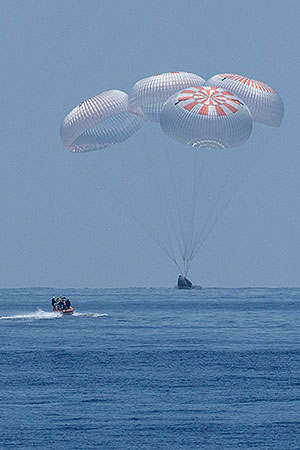
SpaceX's Crew Dragon "Endeavour" splashes down in the Gulf of Mexico, off the coast of Pensacola, Florida, with NASA astronauts Bob Behnken and Doug Hurley aboard, on Sunday, Aug. 2, 2020. The spacecraft returned from the Demo-2 (DM-2) mission after 63 days docked at the International Space Station. (NASA/Bill Ingalls)

NASA astronauts Bob Behnken (at left) and Doug Hurley are seen inside the SpaceX Crew Dragon "Endeavour" on board the SpaceX GO Navigator recovery ship shortly after having splashed down in the Gulf of Mexico off the coast of Pensacola, Florida, Sunday, Aug. 2, 2020. (NASA/Bill Ingalls)
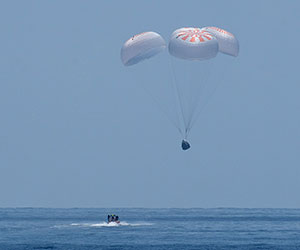
SpaceX's Crew Dragon "Endeavour" descends under parachutes towards a splashdown in the Gulf of Mexico with NASA astronauts Bob Behnken and Doug Hurley, Aug. 2, 2020. (NASA/Bill Ingalls)
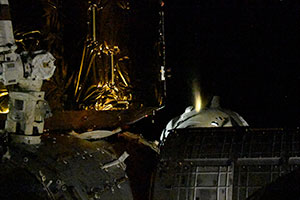
Partially obscured by the International Space Station's Harmony and Columbus modules, Crew Dragon Endeavour is seen firing one of its thrusters just seconds after undocking in this photo taken by Expedition 63 commander Chris Cassidy on Aug. 1, 2020. (NASA)

Transfer bags and other supplies float outside the hatchway leading into the Demo-2 Dragon, awaiting being packed aboard Endeavour to be returned to Earth. Among the items are the "Capture the Flag" American flag and the "Little Earth" and "Tremor" toys. (NASA)
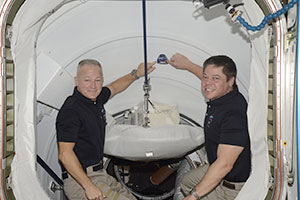
Continuing a 20-year tradition, Doug Hurley (left) and Bob Behnken added their Demo-2 mission insignia to the International Space Station. As the first commercial crew, they chose a new area for the decal inside the pressurized mating adapter's vestibule. (NASA)
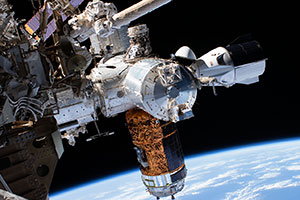
SpaceX's Crew Dragon Endeavour (at right) is seen while docked to the International Space Station in a photo taken during a July 1, 2020 spacewalk. (NASA) |
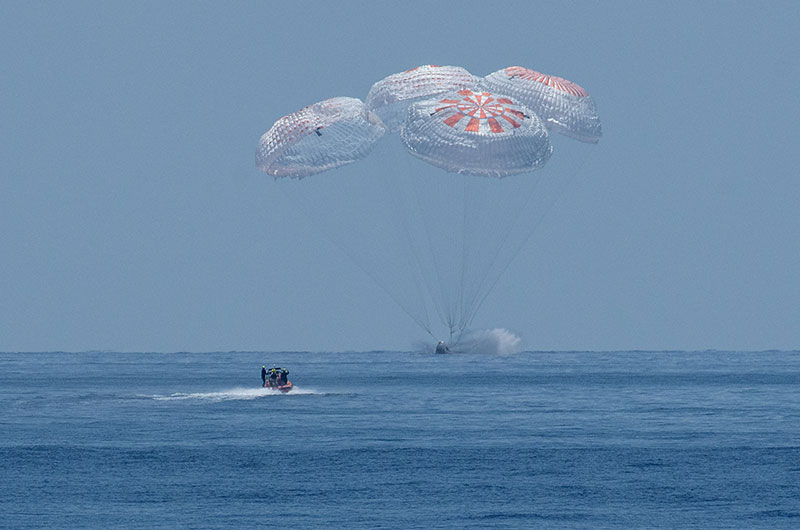
The SpaceX Crew Dragon "Endeavour" spacecraft is seen as it lands with NASA astronauts Bob Behnken and Doug Hurley in the Gulf of Mexico off the coast of Pensacola, Florida, Sunday, Aug. 2, 2020. (NASA/Bill Ingalls) |
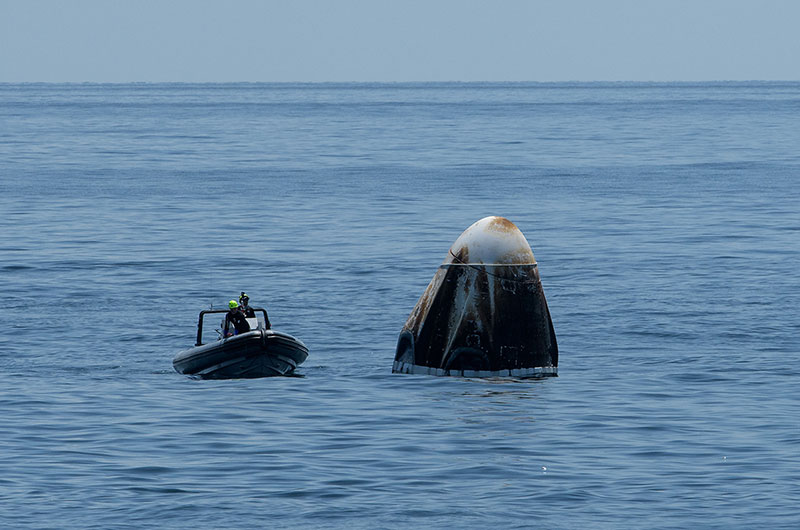
Support teams arrive at the SpaceX Crew Dragon "Endeavour" shortly after it landed with NASA astronauts Bob Behnken and Doug Hurley in the Gulf of Mexico off the coast of Pensacola, Florida, Sunday, Aug. 2, 2020. (NASA/Bill Ingalls) |
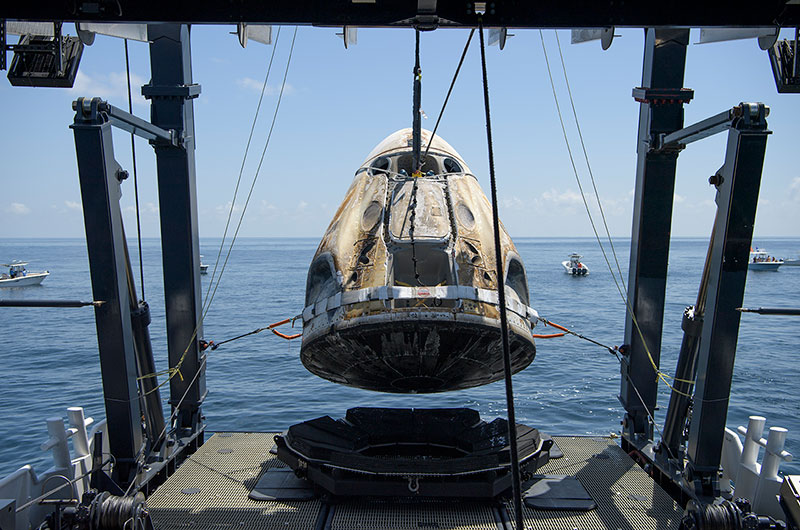
The SpaceX Crew Dragon "Endeavour" is lifted onto the GO Navigator recovery ship shortly after it landed with NASA astronauts Bob Behnken and Doug Hurley in the Gulf of Mexico off the coast of Pensacola, Florida, Sunday, Aug. 2, 2020. (NASA/Bill Ingalls) |
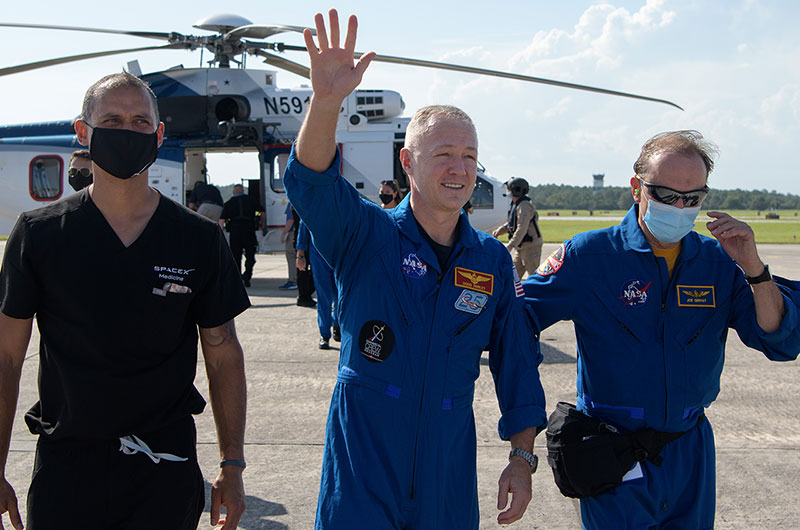
NASA astronaut Doug Hurley waves to onlookers as he boards a plane at Naval Air Station Pensacola to return him and Bob Behnken to Houston a few hours after the two landed in their SpaceX Crew Dragon "Endeavour" off the coast of Florida, Sunday, Aug. 2, 2020. (NASA/Bill Ingalls) |
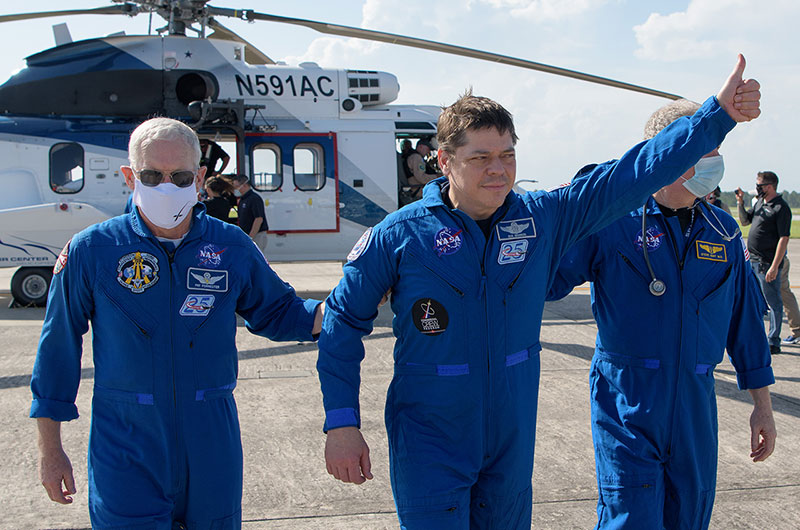
NASA astronaut Bob Behnken gives a thumbs up to onlookers as he boards a plane at Naval Air Station Pensacola to return him and Doug Hurley to Houston a few hours after the two landed in their SpaceX Crew Dragon "Endeavour" off the coast of Florida, Sunday, Aug. 2, 2020. (NASA/Bill Ingalls) |
|

© collectSPACE. All rights reserved.
|
|

|

|
